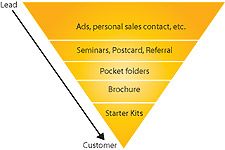Get ready for new business
We all have the need for marketing collateral materials designed to help present our business to prospective clients. Many laboratories have “starter kits” or “presentation pocket folders” while some laboratories have no materials to help them distinguish their laboratory services from the competition.
We all have the need for marketing collateral materials designed to help present our business to prospective clients. Many laboratories have “starter kits” or “presentation pocket folders” while some laboratories have no materials to help them distinguish their laboratory services from the competition.
Folded in
Let’s put the first two marketing tools mentioned in proper perspective. The pocket folder is primarily used to send out to prospective dentists who have expressed an interest in a laboratory’s services, often in response to a sales call, a direct mail piece, a phone call or any other inquiry. The starter kit is mainly used to provide information, samples, Rx forms, shipping boxes or other items to dentists who have either sent in their first case or have expressed a need for materials so they can send a case.
From a sales or marketing perspective, either will work as a follow up tool to interested parties. However, sending a starter kit to a prospect who has not had any previous contact from the laboratory can be expensive and may not provide enough return to offset the expense. Pocket folders, when used correctly, can be less costly and more effective in the sales process.
Many laboratories use pocket folders for sales follow-up and solicitation of new customers. Many of these folders contain the same type of collateral materials (sales literature from the same manufacturers) and are usually over-stuffed with too much information. Often a dentist will request information regarding a specific product and the laboratory will respond by sending out a pocket folder containing information regarding all of their products and services. This can be confusing and irritating to a dentist who only wanted details about one product or service.
This also means the laboratory has nothing left to follow up with as all of their information has been sent out to that dentist; expensive and not very effective.
Pyramid planning

Let’s explore the sales process from lead to the point of sale, and what types of collateral materials you could use in your pocket folder to be cost effective and more selective. Keep in mind that if a dentist asks for information regarding a specific product, technique or service, you should reply only with the requested information. By doing this, you respond to the inquiry while retaining additional marketing materials with which to continue to try to gain additional interest in your laboratory.
Figure 1 illustrates how you might view the sales process and what types of collateral material might be used and at what stage of the sales process.
All of your collateral materials should be used as aids to help you move your prospect from the lead position down the pyramid to the base, which is the customer position. Note that the last position in the pyramid is titled “Starter Kits,” which gives potential new clients all the proper information and tools to send their first case to your laboratory.
The inverted pyramid contains all the marketing pieces you could use to gain a prospect’s attention. The top row is bigger meaning there are more touch points (contact with potential customers) such as ads, sales calls or others. As you move down, you will notice that you will need less and less marketing materials. Early in the sales process you might entice someone with product information, and as you move down to the apex of the pyramid you will need more specific information to answer the question: Why should I use your laboratory?
Types of marketing materials you should consider include:
- Sales flyers
- Technical bulletins
- Direct mail postcards
- Direct mail brochures with Business Reply Cards
- Specific brochures about one department such as implants or cosmetics
- Manufacturer literature, prep guides, etc.
- Personalized corporate brochure
- E-newsletters or e-mail blasts
- Well designed website
Standing out
As you can see, there are quite a few pieces of literature that could be used to consistently “touch” your prospect. According to Jay Conrad Levinson, author of an article titled “Frequency in Marketing” (gmarketing.com/articles) it can take as many as 20 views of a single ad to get a person to respond. So, it makes sense that the more touches you offer using different types of marketing collateral the better the chances that you will get a prospect to respond.
When selling to prospects that have not heard of your laboratory, use product-based marketing materials that have a mix of manufacturer literature and literature that is specifically designed for your laboratory. As you move closer to the apex of the pyramid, use more materials that talk about your laboratory and what makes it unique.
Most laboratories boast of delivering high-quality restorations, consistently, on-time and with great customer service. To set yourself apart, you need to tell a story, give them information as to why your laboratory is different, and continue this process until you gain their confidence and ultimately, their work. The entire process is about the presentation-do it right and you will gain new clients and grow your company.
Product Bites – September 15, 2023
September 15th 2023With half-a-dozen new products, this is a busy week for Product Bites. This week we feature the debuts of ClinicCAD from Medit, Multi-Unit Abutments from Neoss Group, CURIE Plus from Ackuretta, Samba robotic toothbrush from CURAPROX, Remedo AI website design, and the CA 1:2.5 Micro-Series handpiece attachment from Bien Air. [6 Min]